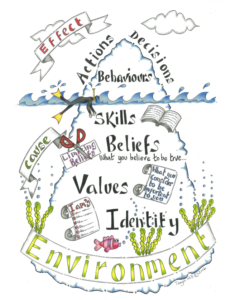We’ve all been there.
You commit to a new habit. You promise to lead your team differently. You tell yourself this time will be different.
And for a little while, it is. You show up early. You follow through. You check all the boxes.
But weeks (sometimes days) later, you find yourself slipping back into the same old patterns.
Why?
Because you tried to change the behaviour, without changing the beliefs driving it.
This is why the Identity Iceberg is such a powerful model that explains why surface-level change rarely lasts, and what it really takes to transform results in your business, leadership, or life.
What is the Identity Iceberg?

Imagine an iceberg floating in the sea. The part you can see above the surface represents your behaviors — the things you say, the actions you take, the habits others observe.
But that’s just a small part of the picture.
Below the waterline lies the biggest part of the iceberg. This is where your beliefs, values and identity live. And it’s this hidden structure that drives every decision, reaction, and result you create.
Here’s a simplified breakdown of the layers:
- Environment – Your surroundings, circumstances, and external influences
- Behaviors – What you say and do
- Skills – What you’re capable of doing
- Beliefs & Values – What you think is true and important
- Identity – Who you believe you are
Real, sustainable change happens from the bottom up, not the top down.
Why This Matters
Let’s say you struggle with delegation in your business. You know you should hand more off to your team, but you keep doing it all yourself.
You might assume the problem is skill-based — that you just need a better system or tool. But if we apply the Identity Iceberg, a deeper picture emerges.
- Your behavior: You micromanage.
- The skill gap: You may lack trust-building or training skills.
- The belief: “If I don’t do it, it won’t be done right.”
- Your identity: “I’m the only one who can keep this business running.”
Until you shift the belief (“My team is capable and can grow”) and the identity (“I am a leader, not a doer”), no tool or tactic will stick. You’ll default right back to micromanagement.
The Be-Do-Have Model: The Identity Iceberg in Action
At ActionCOACH, we use a simple framework that ties into the Iceberg:
Be → Do → Have
Most people operate backwards:
“When I have more time/money/confidence, then I’ll do the thing, and I’ll finally be successful.”
But that’s not how change works.
Real transformation starts with who you’re being — your identity, beliefs, and mindset.
“When I am focused and committed, I’ll do the work that matters, and I’ll have the results I want.”
Want different results? Don’t start by doing more. Start by being different.
Here are three questions to help you apply the Identity Iceberg to your own life or leadership:
- What pattern or behavior is not serving me right now?
(e.g., avoiding difficult conversations, procrastinating, overcommitting) - What belief might be driving that behaviour?
(e.g., “Conflict is bad,” “I’m not good enough,” “Busy means important”) - Who would I need to become to shift this pattern?
(e.g., courageous, grounded, trusting, strategic)
Your Iceberg is Yours to Shape
The beauty of the Identity Iceberg is that it gives us power.
If you’ve been stuck in a loop of behaviour change that never sticks, it’s not because you’re lazy or broken. You’re just working at the wrong level.
By exploring and reshaping the beliefs and identity beneath your behaviors, you don’t just change what you do — you change who you are becoming.
And from that place, everything above the waterline shifts.





